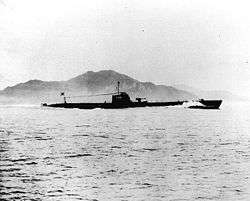Japanese submarine I-168
 The I-168 in March 1934. | |
| History | |
|---|---|
| Name: | I-168 |
| Builder: | Kure Dockyard |
| Launched: | 26 June 1933[1] |
| Commissioned: | Kure Dock Yard on July 31, 1934 |
| Fate: | sunk on 27 July 1943 by USS Scamp (SS-277) |
| General characteristics | |
| Class and type: | KD6 Type, Kaidai class |
| Displacement: | 1400 (1785 maximum) tons surface, 2440 tons submerged[1] |
| Length: | 322' 10" |
| Beam: | 26' 11" |
| Draught: | 15' |
| Propulsion: | Twin shaft Kampon 9000 horse-power/two stroke diesels bhp |
| Speed: | 23 knots diesel/8.2 knots electric[1] |
| Range: | 14,000 nautical miles[1] |
| Test depth: | 230' |
| Complement: | 60-84 officers and men |
| Armament: | 6 Torpedo Tubes/14 21" torpedoes/1 X 4" AA Gun/1 X 13mm AA Gun |
The Japanese submarine I-168 (I-68, until 20 May 1942) was a Kaidai type of cruiser submarine active in World War II.[1] A KD6 sub-class boat, I-168 was built for the Imperial Japanese Navy (IJN) in the early 1930s. At the Battle of Midway she sank the only American warships lost in the battle: the aircraft carrier USS Yorktown (CV-5) and the destroyer USS Hammann (DD-412). At that time she was commanded by Lieutenant Commander Yahachi Tanabe.
Early career
The submarine was completed at the Kure Dock Yard on July 31, 1934. She was originally designated I-68. On November 23, 1941, I-68 and the rest of Submarine Squadron 3 were stationed near Hawaii to perform reconnaissance duties in preparation for the impending attack on Pearl Harbor. Still on station near Hawaii on December 13, I-68 was subjected to 21 separate depth charge attacks. The last attack damaged her batteries and flooded the aft torpedo tubes. After undergoing repairs at Kwajalein, I-68 conducted several uneventful patrols in the Pacific, before being redesignated I-168 on May 20, 1942 as part of a general submarine re-numbering program undertaken by the IJN.
Battle of Midway
I-168 was one of 13 submarines forming the Advance Expeditionary Force of the Japanese attack on Midway. Under the command of Tanabe Yahachi, she steamed south of Midway as far as Kure Island during her approach on 31 May 1942. The American aircraft carriers had passed through the area of the submarine patrol line before the submarines arrived on their patrol stations. I-168 spent the first three days of June observing Midway's southern horizon through the periscope by day and through binoculars at a range of five miles at night. I-168 observed and reported heavy aircraft activity indicating the island anticipated the Japanese attack. She made periscope observations during the first Japanese air attack on Midway. I-168 commenced shelling Midway with its 10-cm (4-inch) deck gun at 0130 5 June; but submerged when illuminated by shore searchlights after firing only 6 rounds.[2]
I-168 was unsuccessfully attacked by aircraft on 5 June; and upon surfacing after the attack, received orders to sink the damaged American aircraft carrier USS Yorktown. Lookouts detected Yorktown, and the destroyer Hammann alongside her at 0530 6 June. I-168 closed the range from 11 miles at six knots, and then slowed to three knots for the final approach through Yorktown's destroyer screen. Over-cautious use of the periscope resulted in getting too close to the carrier on the initial approach, so the submarine circled to starboard to increase the range and then fired a salvo of four torpedoes at 1330 from a range of 1200 yards. After observing the torpedo hits, I-168 descended to 200 feet and slowed to three knots directly under Yorktown. American destroyers Gwin, Hughes, and Monaghan dropped 60 depth charges before damaging I-168 at 1530. A depth charge exploding near the bow put out the lights, damaged the forward battery room, sprung the hatches to No. 1 torpedo tube and reduced the submerged depth to 60 feet. All unoccupied crewmen grabbed sacks of rice from forward storage and moved astern to trim the submarine because of the flooding forward. After a few hours of relative quiet, I-168 surfaced an hour before sunset and ran west at 14 knots to charge batteries and ventilate interior spaces. Two American destroyers spotted her at a range of 11000 yards and commenced firing from a range of 6500 yards about 30 minutes later. I-168 submerged and evaded the approaching destroyers.[3]
After conducting emergency repairs, Tanabe and his crew limped back to Japan using only two engines, a journey of twelve days. Following full repairs at Sasebo, I-168 was placed under the command of Lieutenant Commander Katsuji Watanabe and reassigned to cargo transportation missions to the beleaguered Solomon Islands and Kiska.
Fate
On July 27, 1943, I-168 engaged the American submarine USS Scamp in the Steffen Strait near New Hanover Island. After crash-diving his boat under an incoming torpedo, Lieutenant Commander Walter Gale Ebert returned fire, sinking I-168 with all hands.
Notes
References
- Jentschura, Hansgeorg; Dieter Jung; Peter Mickel (1977). Warships of the Imperial Japanese Navy, 1869-1945. Annapolis, Maryland, USA: United States Naval Institute. ISBN 0-87021-893-X.
- Tanabe, Yahachi (May 1963). "I sank the Yorktown at Midway". United States Naval Institute Proceedings magazine.
- Tabular record of movement at